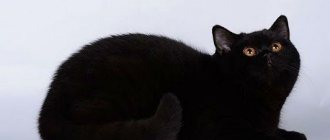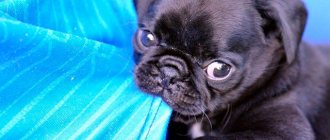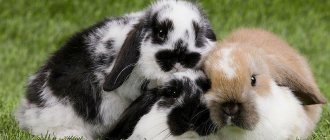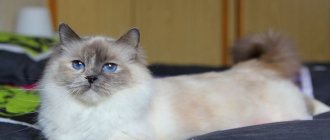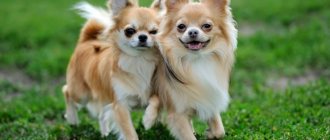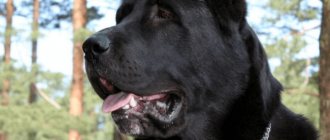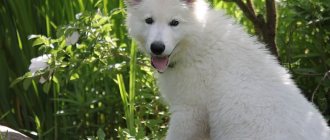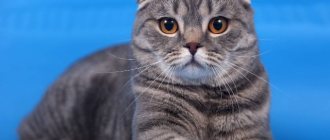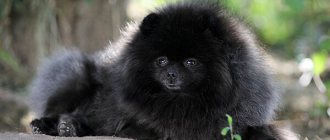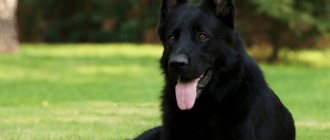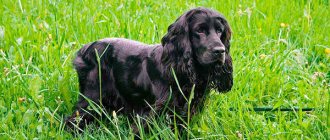The Scottish Fold is a young cat breed. The first kittens appeared a little over 50 years ago - in the 60s of the 20th century. Animals with folded ears quickly fell in love with buyers, first conquering Europe, and then moving to the United States.
One of the features due to which the black fold-eared cat has become the favorite of a large number of people is its straight stance. Imitating gophers, these animals like to sit on their hind legs, raising their body, and lowering their front legs. Only their goals are different - this is how the animals knead the bones of the spine.
Surprisingly, although the black fold cat belongs to the cat family, in most cases he is afraid of heights. This feature is due to the structure of the vestibular apparatus. But when playing, they do not jump on the curtains and rarely jump on cabinets. Fold-eared Scots love to play and fool around, but they will do it with dignity.
Story
The first animal of this breed, Susie, appeared in Scotland from a semi-wild cat. The father remains unknown.
Quite early, Susie began to bear offspring, which the owners had difficulty placing with friends. In 1963, a resident of Scotland, Mary Ross, received one of Susie's kittens as a gift - it was a white cat, nicknamed Snooks. Her first offspring revealed a kitten very similar to those we know today as Scottish Folds. It was a white cat with heavy paws, who was named Snowball. The owner did not have the skills of a breeder, but the woman thought that she had a chance to see the birth of a new breed.
After Snowball grew up, he was crossed with a British Shorthair. At the same time, in the next mating, Snooks was bred with a British blue. It was in this simple way that the first Scottish Fold cat was obtained at home. The black color of the first litter and folded ears attracted the interest of the breeders, who helped Mary develop the final breeding algorithm.
Over the past few decades, this breed has become one of the most sought after throughout the world. As a result of a malfunction in the gene pool that arose due to crossbreeding with short-haired cats, geneticists had to make a lot of effort to eliminate it. If both parents were lop-eared, such crossing sometimes led to disorders in the musculoskeletal system. This is what forced the use of partners of the Scottish breed who do not have folded ears in breeding.
The fold-eared black cat most often appears with normal ears. They fold only after four weeks after birth.
Most Popular
What color Scottish cats will have depends on the color of the cat and the female individual involved in the crossing. The first Scottish babies were most often born with a fur coat of a bluish tint. Gradually, breeders achieved the appearance of new coat tones; currently more than 70 types of color are known.
Black
The Black Scotsman belongs to the solid color group. According to the breed standard, the fur of these pets should be uniform. Black pets have a bright charcoal color, without interspersed with a large number of individual light spaces; Only 2 hairs are allowed.
Orange, with red, marks are considered an indicator of marriage. Black is considered one of the favorite colors for Scots owners. In Moscow, black Scottish Folds can be bought at the Anthology nursery.
White
The white Scottish Fold cat has different eye colors: red, sky and amber. The coat is crystal clear, the paw pads and the tip of the nose are pinkish. The cubs may have small spots, but in a purebred animal the fur will become one even tone. They no longer worry about an adult pet of this color: the shade will not change. The best known variants are white cats with blue eyes.
Grey
The Scottish Gray cat is usually born with blue eyes, although eye color may vary. The nose and paw pads are tinted grey.
Smoky
A smoky pet appears, a representative of the black smoke color due to the presence of a gene that is responsible for a silver tint. Some clubs do not consider coloring as a sign of purebredness and do not allow the animal to participate in exhibitions. Eye colors are orange and green.
Ginger
A ginger or red Scots cat is a rare occurrence. At the end of the tail, the carrier of the species usually has hairs of different colors. There are pets with patterns on the forehead and paws.
Peach
The pupil's cream coat is similar to the fur of his red counterpart, but its shade is lighter. The Peach Scot may have small patterns on the limbs and tail; the presence of large bright leopard patches is considered a defect.
Chocolate
Chocolate is a warm, rich variant of wool. White spots should not dilute the main tone. The presence of the chocolate gene in each of the parents is considered a prerequisite for the appearance of such a kitten.
Brown
Brown, a rare variant of the coat color of the Scottish cat. The eyes are usually copper or yellowish in color.
Blue
Blue is the most common type of Scottish cat. It has shade options, noble rich color. The main tone can have a gray sheen or blue. A pattern can be noticeable on the fur of babies, which disappears by 3 months and the fur becomes uniform.
Lilac
The lilac cat, a representative of the Scottish Fold, inherits its color from its parents, carriers of the gene. This is a clarified chocolate tint, cool, without redness. Their eyes are usually yellow or amber.
Lavender
The fur resembles lavender in color. Close to the appearance of a purple pet.
Faun (deer)
Unlike the lilac cat, which has a lilac tint, the deer pet looks like a light beige Scotsman. Their paw pads and nose mirror are pink.
Cinnamon
Cinnamon is sometimes confused with chocolate. The shades are similar, but the first one is softer and a little lighter, not so rich and bright. Nose and paw pads are beige.
Tortoiseshell
According to the breed standard, only Scottish cats can have a tortoiseshell color (a mixture of black and red); the presence of such fur in males is considered a marriage and such cats are not allowed for breeding. Most often, three shades predominate in a fur coat, (a tricolor cat) sometimes there are more. There are no specific rules for the distribution of the pattern. The only condition is a uniform color ratio.
Gold
Pets with golden fur are not so common, the owners of the color are chinchilla cats. The animals look quite impressive. It is difficult to develop a shade, but there are nurseries that work specifically on this color.
Silver
Silver is one of the most noble shades of Scottish fur. The color of the hairs should be clean without “rusty” spots or yellowness. The undercoat is also even in color.
Striped
Striped is one of the most common patterns; dark stripes are located on light hairs. Due to the interesting color combination, the pet resembles a tiger.
Tabby
Inexperienced pet owners consider tabby cats to be a type of Scottish cat. But tabby is a color, a kind of zonal pattern on the coat. The pattern may resemble the letter “M” in the forehead area, or there will be separate stripes on the cheeks. The sections of tabby cats should be narrow, their outlines bright and stand out against the general background.
The tabby pattern is also popular among ordinary household representatives. Tabby owners cannot have absolutely identical patterns.
Marble
The classic marble pattern, in addition to stripes, includes spots and curls with rings, randomly located along the pet’s body. The sample got its name from the fact that it resembles a marble pattern.
brindle
With a tiger coat, the stripes are located vertically, on both sides of the body. The pattern on the neck resembles a collar, and the tail has a distinct pattern. On the back, the stripes connect and form a kind of “saddle”.
Bicolor
Bicolors include two-color colors. The main color of the pet in this case is white; it occupies half or slightly less of the surface of the fur coat. Combines with a second color: one of the solid, monochromatic options.
Pets with Van fur have a widely colored tail and spots on the face. Spots on the legs and body are allowed: one, two.
A harlequin cat is 4/5 white, and the tail, ears and top of the head are black as standard.
Tricolor
Most often, cats have a tricolor color. Against the background of the main color, spots of two more shades stand out.
Color point
On the surface of the body, the color point's coat is light, and the muzzle, ears and paws are dark.
Appearance
Light blue coat color is considered classic. But since a large number of different exotics took part in the formation of the breed, today a huge variety of colors is acceptable. Scots can be blue, cream, white, bicolor, black, tabby, chinchilla and so on.
The head of animals of this breed is round, with a flat forehead, drooping ears. The legs are relatively short, the paws are rounded. The nose is straight and wide. The fur is short and thick.
On average, a black fold cat weighs 8 kg.
Colors of Scottish Straight cats
There is no difference in coat color variations between Scottish Straights and Folds. Cats with straight ears come in exactly the same colors as their fold-eared relatives:
- plain;
- bicolor;
- point;
- tipping;
- tabby
Similarly with the long-haired “Scots” (Highland Fold and Highland Straight), they are also characterized by all of the listed colors.
INTERESTING! As Scottish kittens grow, the color of their coat gradually changes. The final color is formed when the animal reaches 2 years of age.
The most popular are smoky, chinchilla, single-color, tortoiseshell, and shaded representatives of the straight-eared Scottish variety.
Intelligence
Animals are playful and quite active - this is especially true for kittens. They quickly get used to sitting in their owner's arms. The black fold cat is prone to basic training. These animals quickly figure out what purpose there is a scratching post in the house; some individuals are able to turn on and watch TV.
The intelligence of Scottish Folds is at a fairly high level, their intuition is well developed, and they are highly adaptable. These animals are able to quickly get used to any environment, “read” the owner’s emotions, adapting to his mood. Fold-eared pets are non-aggressive, they are almost unable to take revenge.
Beliefs and signs about black cats
In England, where the lineage of fold-eared cats began, the attitude towards black animals is completely different from how they are perceived in eastern countries.
- In Scotland, meeting a black cat is considered a good omen.
- If a black cat enters someone else's house, it means that a happy surprise awaits its owners. This has been believed in the English provinces for many centuries. Therefore, a saucer of milk is often left near the house in case an unfamiliar four-legged guest arrives.
- Black cats are highly prized by British sailors. Since ancient times, such animals have been considered the best rat catchers. For the same reason, farmers selected black cats.
- For the fair sex, a black cat attracts suitors to the house and increases the girl’s chances of a successful marriage.
The black fur of fold-eared cats has not become the subject of a negative reputation for these cats. They look too funny to inspire fear or apprehension when you meet them. With good heredity and proper maintenance, Scots live up to 15 years.
They delight others with their gentle character, good disposition, sociability and impeccable politeness, which is inherent in real Englishmen.
I like3I don't like
Character
The character of these animals is very stable, they do not give in to hysterics, quickly become attached to the house and owner, while being self-sufficient.
A striking feature of the breed is its voice. It does not at all resemble a gentle purr, but rather the creaking of old wood. Scots rarely shout, mostly communicating their needs in a polite manner.
In conflict situations, ordinary cats hiss, bite, and show aggression in every possible way. However, this does not apply to the Scots, who are born diplomats. If they could go to work, they would certainly get into politics!
Socialization
These animals get used to their family extremely quickly. Experienced owners are sure that cats treat children and elderly family members with special tenderness. If they really like a person, they will follow him everywhere, trying to attract attention. However, no matter how much they want to socialize, they will not distract from business by grabbing your legs or jumping on your lap. The most important thing for these cats is to be close to their loved one.
Other animals, including cats, please the Scots as they love good company. Even living together with a dog does not spoil the cats’ mood - they quickly get used to such a neighbor, playing with him and even caring for his fur.
Reviews
Some owner reviews:
- “I fell in love at first sight. Our Vaska is a very beautiful cat, and prone to narcissism. He can sit in front of the mirror for an hour and look at himself. There are no problems with him. Sometimes he confuses a scratching post with a sofa, and his toys with my books.”
- “When our son was born, we had to take Jason to his parents in the village. The cat constantly hissed at the baby, which did not stop him and the child continued to climb towards the cat. In the end, the inevitable happened - our son was scratched all over, and the cat moved away from us.”
Peculiarities
The high intelligence of cats of this breed indicates their good learning ability, however, screaming can forever discourage the animal from obeying. Moreover, a cat can become aggressive and cowardly if you shout at it regularly.
Fold-eared Scots do not tolerate rudeness. So, it will not be possible to carry cats of this breed by the scruff of the neck - they simply will not allow it. Firstly, because due to their severity, this position is painful for animals. Secondly, it is harmful to the spinal column. Cats need to be carried in such a way that all paws can rest on something in the air.
The owner must be extremely patient to raise a Scotsman. It is important to understand the individual characteristics of cats. For example, remember that even the smartest animal is not able to remember several commands. It is necessary to move from simple to more complex exercises.
Care
Most breeders talk about the low whimsical nature of cats of this breed. Their fur must be brushed daily with a massage brush. Animals get used to this quite quickly, enjoying the procedure that is beneficial for their health.
The fold-eared black cat, whose photo will decorate any catalog of breeds, contrary to stereotypes, does not resist bathing. Often gets used to water procedures after three to five times. Despite this, you can wash it only if absolutely necessary - if fleas appear or there is significant contamination.
The unique shape of the ears leads to the rapid accumulation of dust and wax in them. Therefore, you should inspect them regularly - 2-3 times a month. When cleaning, use a cotton swab coated with ear hygiene liquid.
Animals need to trim their claws no more than once a month - for this you should buy a steel nail clipper and a scratching post. The claw must be trimmed by 2 mm. You should not use scissors - this can harm the animal’s nerve endings or fingers.
Nicknames
Many owners, having acquired a new pet, are tormented by the question of what to name a fold-eared (black) cat. First of all, you should take into account that purebred animals have pedigrees and breeder marks. Each kitten is registered, so all animals from the same litter must have names starting with the same letter - this narrows the list.
The Scottish Fold (black) cat can be named anything, but most owners still prefer beautiful, sonorous nicknames that will sound good at exhibitions. For a home, purebred animals most often have a simpler, shorter and more convenient name. For example, King all Round at home may well turn out to be Bantik.
Diseases
Owners need to take care of the health of a cat prone to longevity. Despite the fact that the average lifespan of a lop-eared cat is 19 years, you need to regularly take them to the veterinarian and monitor their well-being at home.
First of all, you should monitor the cat’s appetite, sociability and behavior. If there are warning factors, it is necessary to check the temperature, take the pulse, and pay attention to other symptoms. If something bad happens to your animal, you should immediately consult a doctor.
Color table
International system for determining the colors of folds and straights of Scottish cats, as well as Highlands. Information about the types of colors and the location of the pattern is enclosed in a code entry of numbers and alphabetic expressions. Numbers-colors, letters-designations.
Scottish cat color chart.
| A | Blue |
| b | Chocolate, brown, chestnut (Chocolate, brown, Havana, champagne) |
| With | Lilac, lavender (lilac, lavender, platinum) |
| d | Red, flame (red) |
| e | Cream |
| f | Tortoiseshell, atch (Tortoiseshell) |
| g | Blue-cream, blue-tortie (blue cream, blue tortoiseshell) |
| h | Chocolate-tortie (chocolate tortoiseshell) |
| j | Lilac-tortie (lilac tortoiseshell) |
| n | Black, ebony, seal, sable, ruddy (black, ebony, seal, sable, wild) |
| o | Sorrel, cinnamon, honey (sorrel, cinnamon, honey) |
| p | Beige-fawn (yellow-brown, beige) |
| q | Sorrel tortie (red brown tortoiseshell) |
| r | Beige fawn (yellow-brown, beige) |
| s | Silver, smoke (silver, smoky) |
| w | White |
| x | Unregistered (unregistered color) |
| y | Golden (golden) |
| 01 | Man (van) |
| 02 | Harlequin (harlequin) |
| 03 | Bicolor (two-color, bicolor) |
| 04 | Mitted, white-point (color point with white marks) |
| 09 | Little white spots (white spotting 1-2cm) |
| 11 | Tabby, agouti (striation, agouti factor) |
| 12 | Tipped, shell (veiled, i.e. 1/8 of the top part of the hair is darkened) |
| 22 | Blotched, marble |
| 23 | Mackerel, tiger (mackerel, tiger) |
| 24 | Spotted |
| 25 | Ticked (ticked or Abyssinian) |
| 31 | Burmese (Burmese) |
| 32 | Tonkinese (Tonkinese) |
| 34 | Singapura (Singaporean) |
Varieties of coat color, as well as eyes and tail length are indicated in numbers.
XXX.xx.NN.NN.NN.(NN); xx - color signs. XXX - designation of the animal breed; NN - numbers.
This precise classification of codes is convenient and is used in international clubs. It is interesting to watch the development of color in a small Scottish kitten. At birth, the baby may be a single color, after a month stripes appear, and the pattern changes with age. The stripes will either disappear or, on the contrary, darken and become more distinct.
The future appearance is determined by the shade of the nose and paw pads. The baby's former owner and the owner of the nursery that provided the baby will answer all your questions regarding the color of Scottish fold cats.
Source
